F10
Solar System’s fastest-orbiting asteroid discovered
Unusual asteroid could help scientists understand the forces that shaped our Solar System’s architecture
Reports and ProceedingsIMAGE: AN ILLUSTRATION OF 2021 PH27’S ORBIT, BY KATHERINE CAIN AND SCOTT SHEPPARD, COURTESY OF THE CARNEGIE INSTITUTION FOR SCIENCE. IT IS THE FASTEST ORBITING KNOWN ASTEROID. view more
CREDIT: KATHERINE CAIN AND SCOTT SHEPPARD, COURTESY OF THE CARNEGIE INSTITUTION FOR SCIENCE.
Washington, DC—The Sun has a new neighbor that was hiding in plain twilight. An asteroid that orbits the Sun in just 113 days—the shortest known orbital period for an asteroid and second shortest for any object in our Solar System after Mercury—was discovered by Carnegie’s Scott S. Sheppard in evening twilight images taken by Brown University’s Ian Dell'Antonio and Shenming Fu.
The newfound asteroid, called 2021 PH27, is about 1 kilometer in size and is on an unstable orbit that crosses that of Mercury and Venus. This means that within a few million years it will likely be destroyed in a collision with one of these planets or the Sun, or it will be ejected from its current position.
Studying objects like this can help scientists understand where asteroids originated and the forces that shaped our Solar System’s architecture. “Most likely 2021 PH27 was dislodged from the Main Asteroid Belt between Jupiter and Mars and the gravity of the inner planets shaped its orbit into its current configuration,” Sheppard said. “Although, based on its large angle of inclination of 32 degrees, it is possible that 2021 PH27 is an extinct comet from the outer Solar System that ventured too close to one of the planets as the path of its voyage brought it into proximity with the inner Solar System.”
Because 2021 PH27 is so close to the Sun’s massive gravitational field, it experiences the largest General Relativistic effects of any known Solar System object. This is seen in a slight angular deviation in its elliptical orbit over time, a movement called precession, which occurs at about one arcminute per century. Observation of Mercury’s precession puzzled scientists until Einstein’s Theory of General Relativity explained its orbital adjustments over time. 2021 PH27’s precession is even faster than Mercury’s. “2021 PH27 gets so close to the Sun that its surface temperature gets to around 900 degrees Fahrenheit at closest approach, hot enough to melt lead,” Sheppard said.
Future observations of this object will shed more light on its origins. Comparing 2021 PH27 to objects that orbit beyond Earth will improve researchers’ knowledge of its composition and the materials that enable its survival under these extreme conditions. An object like 2021 PH27 experiences tremendous thermal and internal stresses due to its proximity to the Sun.
A census of asteroids near and inside of Earth’s orbit is crucial for identifying those that could potentially impact our planet, but are difficult to spot because they approach Earth during daylight. These types of asteroids are not easily detected by most surveys, which usually observe at night. The asteroid will soon pass behind the Sun and be unobservable from Earth until early next year, at which time observers will be able to refine its orbit to the precision needed to give it an official name.
The only efficient method for spotting asteroids that move around the Sun in orbits closer than Earth’s own is to take images as the Sun sets or rises, which Dell’Antonio and Fu did with the Dark Energy Camera on the National Science Foundation’s Blanco 4-meter telescope in Chile. Their main research is part of the Local Volume Complete Cluster Survey, which is observing most of the massive galaxy clusters in the nearby universe with increased detail. In collaboration with Sheppard, Dell’Antonio and Fu switched from focusing on some of the most distant objects in the universe to some of the nearest, using the first few minutes of evening twilight on August 13 to take images in which Sheppard was able to find 2021 PH27 a few hours later.
CAPTION
An artist’s conception of the newly discovered asteroid 2021 PH27, which has the shortest known orbital period for an asteroid and second shortest for any object in our Solar System after Mercury. Illustration by Katherine Cain courtesy of the Carnegie Institution for Science.
CREDIT
Illustration by Katherine Cain courtesy of the Carnegie Institution for Science.
“Because the object was already in the Sun’s glare and moving more toward it, it was imperative that we determine the object’s orbit before it was lost behind our central star,” explained Dave Tholen of the University of Hawaii, who measured the fast-moving asteroid’s position on the sky and predicted where it would be the night after the initial discovery. “I surmised that for an asteroid this size to remain hidden for so long, it must have an orbit that keeps it so near to the Sun that it is difficult to detect from Earth’s position.”
Additional images were obtained the following night using the Magellan telescopes at Carnegie’s Las Campanas Observatory in Chile as well as again with NSF’s 4-meter Blanco telescope. A third night of follow-up observations were needed to determine the new asteroid’s orbit before it was lost, but cloudy weather in Chile elicited a trek around the world to South Africa thanks to the activation of the Las Cumbres Observatory’s extensive network of global 1-meter telescopes.
“Although telescope time is very precious, the international nature and love of the unknown makes astronomers very willing to override their own science and observations to follow-up new interesting discoveries like this,” said Sheppard. “We are so grateful for all of our collaborators who enabled us to act quickly on this discovery.”
VIDEO Discovery of 2021 PH27 [VIDEO] | EurekAlert! Science News Releases
University of Chicago’s Alex Drlica-Wagner, NOIRLab’s Clara Martinez-Vazquez, Stanford University’s Sidney Mau, and Luidhy Santana-Silva of Universidade Cruzeiro do Sul interrupted their first and second nights using the Dark Energy Camera to observe the asteroid. Princeton University’s Scott Carlsten, Rachael Beaton (a Carnegie-Princeton Postdoctoral Fellow), and Jenny Greene were instrumental in the second night follow-up images from Las Campanas and on the third night Pontificia Universidad Catolica de Valparaiso’s Cristobal Sifon and Camila Aro-Bunster delayed the start of their Magellan observing program to image the object through some passing clouds. Marco Micheli of the European Space Agency’s Centre for Earth Observation coordinated the use of the Las Cumbres Observatory’s network.
Fastest-moving asteroid flies closer to Sun than Mercury

Astronomers using the 570-megapixel Dark Energy Camera have found the fastest-moving asteroid yet discovered, a 1-kilometre-wide (0.6-mile-wide) body that crosses the orbits of Venus and Mercury and passes within just 20 million kilometres (12 million miles) of the Sun every 113 days. The asteroid, catalogued as 2021 PH27, heats up to almost 500 Celsius (about 900 Fahrenheit) during close approach, hot enough to melt lead.
Scott Sheppard of the Carnegie Institution of Science discovered the asteroid in data collected by DECam and the Victor M. Blanco 4-metre Telescope at the Cerro Tololo Inter-American Observatory in Chile during an ongoing study of massive galaxy clusters.
After the asteroid was initially spotted on 13 August, David Tholen of the University of Hawaii calculated its orbit. Over the next two days, researchers in Chile and South Africa interrupted already scheduled work to carry out additional observations, confirming the asteroid’s orbit.
“Though telescope time for astronomers is very precious, the international nature and love of the unknown make astronomers very willing to override their own science and observations to follow up new, interesting discoveries like this,” said Sheppard.

The asteroid, catalogued as 2021 PH27, may have originated in the main asteroid belt between Mars and Jupiter, subsequently dislodged by gravitational interactions with the inner planets. But its orbit is tilted 32 degrees to the Sun’s equatorial plane, indicating it could be an extinct comet that ended up in a short-period orbit after passing by a terrestrial planet.
Bodies passing close to the Sun experience extreme temperatures and gravitational stresses that likely cause more fragile asteroids to break up. If the number of asteroids in orbits similar to 2021 PH27’s is small, it could indicate what fraction of near-Earth asteroids are loose “rubble piles” as opposed to more solid bodies. And that, in turn, could shed light on the possible threat to Earth from future impacts.
“Understanding the population of asteroids interior to Earth’s orbit is important to complete the census of asteroids near Earth,” Sheppard said, “including some of the most likely Earth impactors that may approach Earth during daylight and that cannot easily be discovered in most surveys that are observing at night, away from the Sun.”
Doomed comet ATLAS had a long history with Earth
By Ashley Strickland, CNN
Mon August 23, 2021
(CNN)A Comet that intrigued astronomers with its first appearance in our sky at the very end of 2019, but it disintegrated into 30 tiny ice shards months later.
Now, observations made while the comet, named ATLAS, was still intact have shed light on the comet's "family," which stretches back thousands of years.
Comet ATLAS was first detected by the Asteroid Terrestrial-impact Last Alert System, or ATLAS, which is operated by the University of Hawaii, on December 28, 2019.
Quanzhi Ye, an astronomer at the University of Maryland, observed the comet using the Hubble Space Telescope. Ye and his colleagues used their observations to determine that comet ATLAS was actually a remnant from one that likely streaked across our sky 5,000 years ago. This ancient comet came within 23 million miles of the sun, closer than Mercury is to our star, and Stone Age civilizations across North Africa and Eurasia likely witnessed the celestial sight.
There are no records of this sighting, but studying comets in the way that Ye and his team analyzed comet ATLAS helps them trace comet origins. In fact, ATLAS' orbit around the sun followed a similar track as a comet that was observed in 1844, which suggests both of these comets were "siblings" that came from a parent comet that broke apart centuries before.
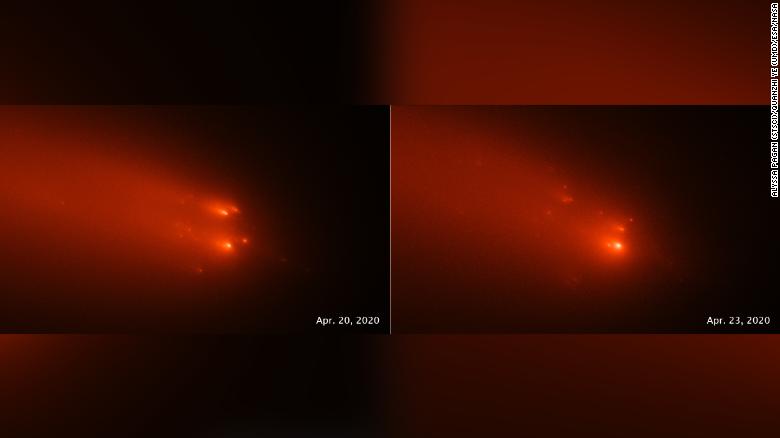
These Hubble images taken on April 20 and April 23, 2020, reveal the breakup of comet ATLAS.
Comet ATLAS and the 1844 comet were originally linked by amateur astronomer Maik Meyer.
It's not uncommon for a comet to break apart into a "family." Multiple telescopes, including Hubble and even the Galileo spacecraft, were focused on Jupiter in July 1994 when the comet Shoemaker-Levy 9 was shredded by the gas giant's gravitational pull. It formed a "comet train" made of pieces of the comet that formed a line.

Largest known comet is heading close enough to us to become visible
The comet's demise had been predicted by astronomers. They watched as pieces of it fell into Jupiter, creating a spectacular fireball and leaving scars on the massive planet that were visible for months afterward.
Comet ATLAS is different, having disintegrated when it was more distant from the sun than Earth -- unlike its parent comet, which was closer to the sun when it broke apart.
"If it broke up this far from the Sun, how did it survive the last passage around the Sun 5,000 years ago? This is the big question," Ye said in a statement. "It's very unusual because we wouldn't expect it. This is the first time a long-period comet family member was seen breaking up before passing closer to the Sun."
When astronomers watch a comet break apart into pieces, they can also determine how it came together in the first place. Comets are gigantic dirty snowballs made of dust and ice that come from the edge of the solar system.
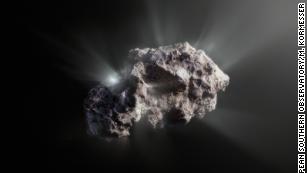
A rare interstellar comet reveals its secrets and 5 other top space and science stories this week
One part of comet ATLAS broke apart within days, while another fragment survived for weeks.
"This tells us that part of the nucleus was stronger than the other part," Ye said.
It's possible that the comet was ripped apart by the material it was ejecting, or it may have blown apart like a firework.
"It is complicated because we start to see these hierarchies and evolution of comet fragmentation. Comet ATLAS' behavior is interesting but hard to explain," Ye said.
Meanwhile, comet ATLAS' sibling, the one observed in 1844, won't be visible in our skies again until the 50th century.
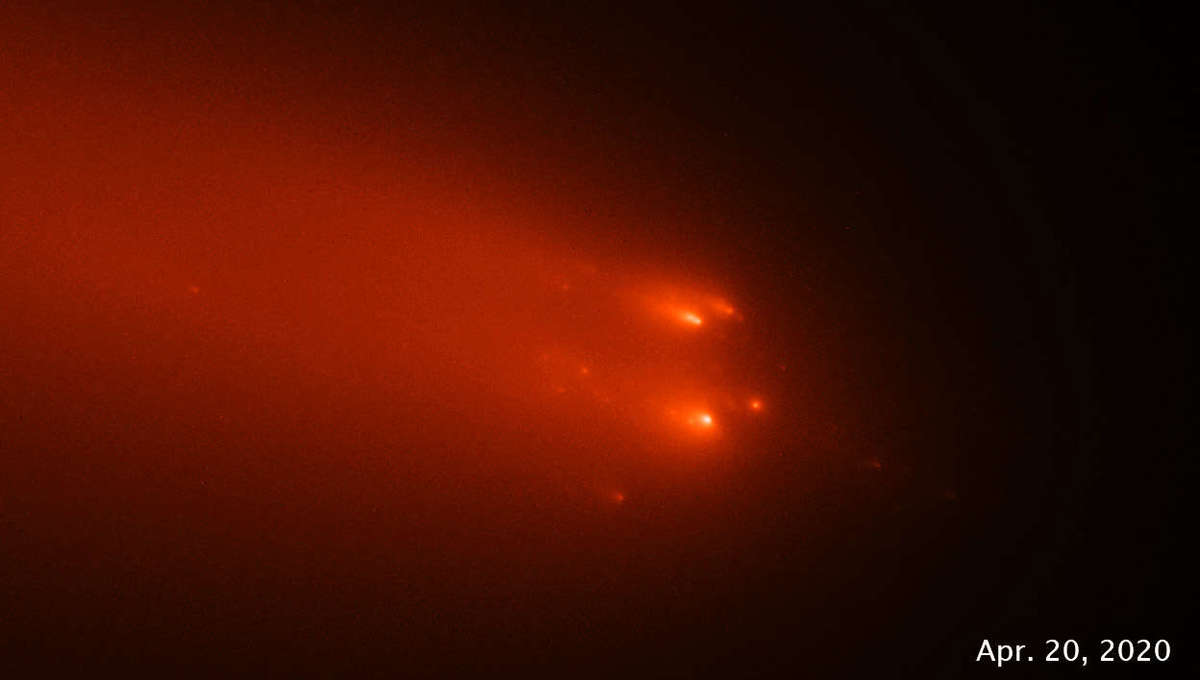
Comet C/2019 Y4 (ATLAS) observed by Hubble on April 20, 2020 (top) and three days alter (bottom). In the earlier image fragment clusters A (above) and B (below) are clearly seen, but in the later image Cluster A had substantially disintegrated further. Credit: NASA/ESA/Quanzhi Ye/Alyssa Pagan

Aug 23, 2021,
On December 28, 2019, a new comet was discovered by ATLAS (the Asteroid Terrestrial-impact Last Alert System). Called C/2019 Y4 (ATLAS) — let's call it 2019 Y4 for short — it had an orbit that brought it to within about 38 million kilometers of the Sun, which is inside Mercury's orbit. Pretty close to the Sun.
In February 2020 the comet brightened rapidly, raising hopes it might become naked eye visible, but about a month later it became clear the opposite was going to happen: 2019 Y4 was disintegrating, and didn't survive perihelion passage, when it got closest to the Sun.
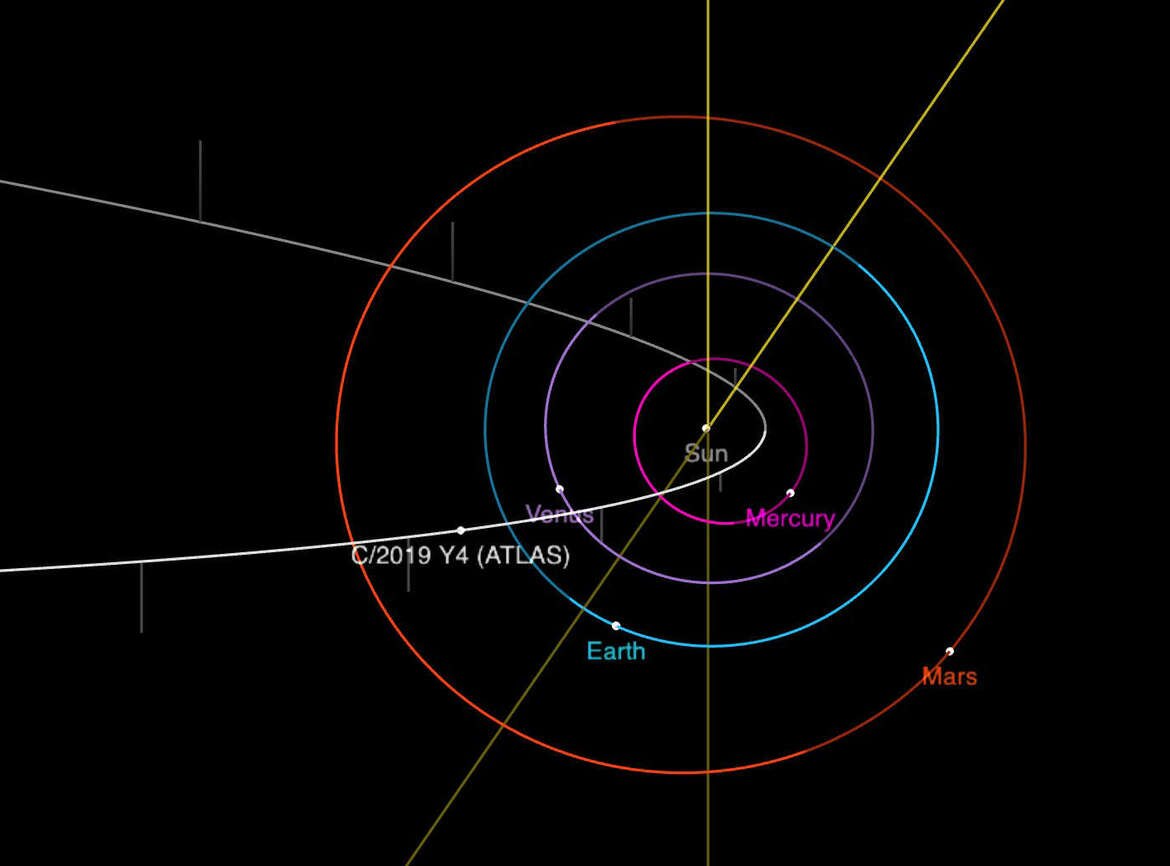
In fact, the comet started breaking apart long before perihelion, when it was well over 200 million kilometers from the Sun, farther out even than Earth is. That was surprising. Now, we've seen comets disintegrate before. They're made of rock, dust, and ice, and when a comet gets near the Sun the ice turns to gas, forming the iconic fuzzy head and long tail. If enough ice does that the comet can break apart. However, that usually happens closer in to the Sun, and in this case the roughly 5,000-year-long orbit of 2019 Y4 implies it's been around the Sun before and survived. Why did it fall apart this time?
A new paper just published may have an explanation, or at least a partial one. Using ground-based and Hubble observations, astronomers looked at how the comet broke up and think it was once part of a larger comet that broke into two (or more) large pieces, one of which became 2019 Y4.
The other? It became a different comet called C/1844 Y1 (Great Comet), one that passed Earth in 1844 and was bright enough to easily see with the naked eye. That comet has an orbit extremely similar to that of 2019 Y4, indicating that they came from the same object.
Despite coming from the same parent, the two comets were very different. 1844 Y1 survived its pass close to the Sun and headed back out into the blackness of the outer solar system, while 2019 Y4 fell apart completely. Why did they behave so differently?

Comet C/2019 Y4 (ATLAS) observed by Hubble on April 20, 2020 (top) and three days alter (bottom). In the earlier image fragment clusters A (above) and B (below) are clearly seen, but in the later image Cluster A had substantially disintegrated further. Credit: NASA/ESA/Quanzhi Ye/Alyssa Pagan
The proposed solution comes from the Hubble observations. The comet broke into several pieces just before Hubble took a look. The two brightest chunks, called A and B, were seen to actually be clusters of debris, some pieces as small as 10 meters across. Given their behavior — A was a smaller group with the pieces closer together — it seemed that Complex B was about two weeks old at the time of the observations, while Complex A was only a few days old.
Moreover, the fragments in Complex A completely disintegrated, while those in Complex B held together fairly well.
These clues indicated that the comet itself was likely nonhomogeneous, composed of different kinds of stuff (perhaps in some places there was more ice, and some more rock). The material that was more ice (Complex A) was more fragile, and fell apart completely, while the rockier part (B) held together somewhat better.
And that's interesting: If 2019 Y4 was non-uniform in structure, its parent comet must have been as well. That would explain how 2019 Y4 fell apart while 1844 Y1 did not. The latter was made of tougher stuff. The astronomers speculate that the parent body was roughly a kilometer wide, with ice beneath its surface. When it broke up, 1844 Y1 was from the stronger crust on the outside, while 2019 Y4 would've been from the more volatile material in the interior.
If that's so, then why didn't 2019 Y4 break up 5,000 years ago during that big split? Perhaps it happened when the comet had already passed the Sun, was weakened by its heat, and then broke apart when it was already pretty far from the Sun on its way out. At that distance the ice inside 2019 Y4 wasn't warm enough to turn to gas, so it survived… at least, until 2020.
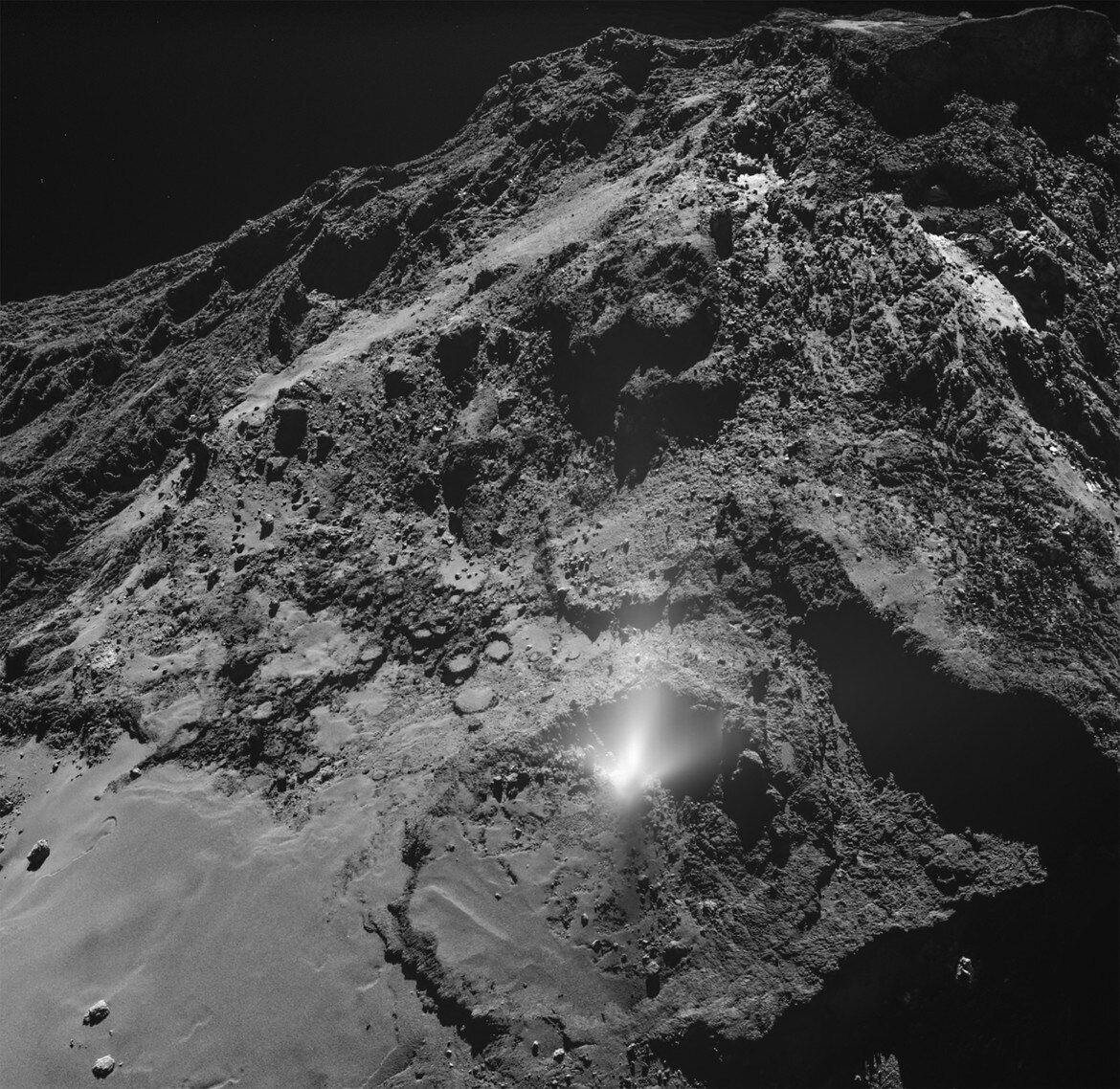
A plume of water and dust erupted on the comet 67/P on July 3, 2016, and was caught on camera by the Rosetta spacecraft from just kilometers away. Credit: ESA/Rosetta/MPS for OSIRIS Team MPS/UPD/LAM/IAA/SSO/INTA/UPM/DASP/IDA
What broke up 2019 Y4 then? Given the age difference between Complexes A and B it looks like the disintegration was either two events or one long slow one. Sometimes ice under the surface will vent out gas as it warms, and that can spin the comet up like a pinwheel. If it spins rapidly enough the centrifugal force can break it up, and then smaller pieces will also outgas and break apart. It's also possible there was one major event (when the comet brightened in February 2020) and then the smaller pieces started outgassing and breaking apart later.
I'll note that this might explain why the two big pieces from the unnamed parent comet passed Earth 175 years apart; outgassing can change the velocities of the comets enough that they separated while keeping the orbits similar, so they passed us at very different times.
Despite having observed thousands of comets, seeing some close up, and having a spacecraft orbit one for years, we still don't understand the internal structures of comets well. Some seem fairly stable while others are as delicate as spun sugar. And sometimes both kinds can come from the same parent body!
There's an old saying about comets, attributed to famed comet-discoverer David Levy, that goes, "Comets are like cats: they have tails, and they do what they want." If their interiors are as chunky and non-uniform as the breakup of 2019 Y4 indicate, then this difficult-to-predict behavior makes a lot more sense.
No comments:
Post a Comment